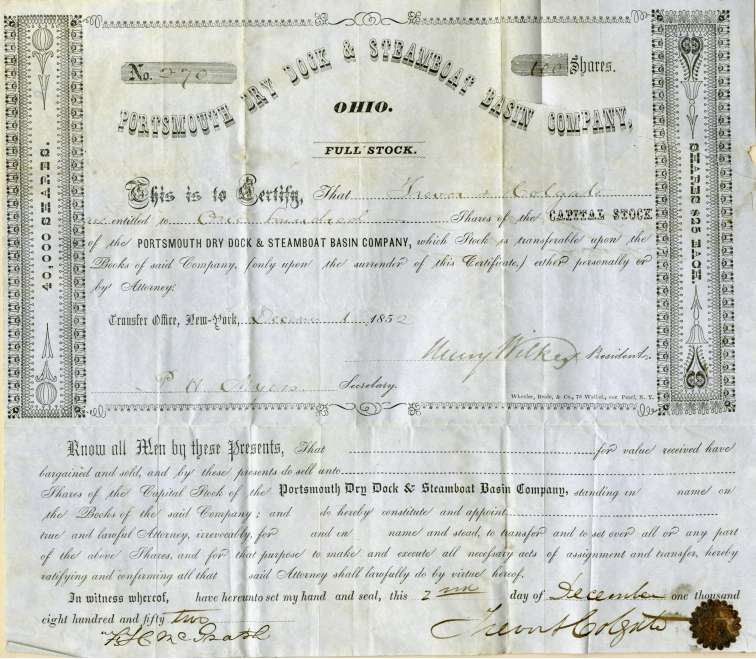Beautiful stock certificate from the Portsmouth Dry Dock and Steamboat Basin Company issued in 1852. This historic document has an ornate with the company's name on top center. This item has the original signatures of the Company's President, and Secretary. 
Certificate HISTORY OF LOWER SCIOTO VALLEY 1884 Portsmouth Dry Dock and Steamboat Basin Company. In 1851 a map was gotten out showing the property of the above-named company, hich consisted of 5,630 lots on the west side of the mouth of the Scioto and a canal basin connected with the State canal by a branch running directly south from a little above the third lock. At the foot of the title of the map in one corner was the announcement: "2,000 lots selected from this parcel to be sold on the 15th May, 1851, in this city by A. H. Muller, Auctioneer." This was one of the visionary schemes which imaginative minds delight to dwell upon, and of which Portsmouth has had no little experience. The great silver shaft of Indian tradition, within five miles of the city, presented a Utopia scarcely less charming than this one. The plat was made for a magnificent city on the wide bottom west of the mouth of the Scioto, extending back to the hills. Seventy-seven streets were laid out and named, and generous reservations for parks were made. Had this magnificent project been fulfilled, and the imagined city taken shape, Portsmouth would now have been the rival of, or probably superior to, Cincinnati. The company of men who conceived and took the initial steps of this project were from New York City. They were attracted to this point by the termination of the Ohio Canal, which many thought would make this a shipping and transfer point of great magnitude, since through it would pass all the trade between the North, East and the great West, which was now being rapidly settled. The first representative of the company here was a Mr. Stockwell, who, after the failure of the scheme, went to Wisconsin, from which he afterward represented a district in Congress. About the same time, or perhaps after Mr. Stockwell had left, Mr. Stillwell, resident of Brooklyn, represented the company here. Their resident agent, who purchased the land (between 500 and 600 acres) and surveyed and platted the city, was Captain Francis Cleveland, an old resident of this city. Many lots were sold at the sale above referred to and a block of three-story brick buildings was erected near the basin between the Ohio and the old bed of the Scioto, used for warerooms. Considerable business was done for a time in the transfer of good, and with the attractions for other branches of business which were being drawn around it the anticipations of the projectors seemed to be on the way to realization. But the high water of the rivers overflowed the land, which was an interference not bargained for. At the same time business began to be taken away from the canal by the railroads, and the embryo city gradually passed out of existence. No trace of the buildings erected there are now to be found. The city plat has long since been cancelled. In December, 1853, Tracy Square was accepted by the council, in which to establish the city park. To show the material growth of the city for the period of ten years preceding 1857, the following figures, showing the taxable valuation, are given: Valuation in 1847, $553,200; in 1853, $1,259, 187; in 1857, $2,447, 624. Since 1837 the town had been spreading back from the river and covering that portion north of Fourth street which prior to that date was covered with forest trees. A general system of wharfage was established in 1852 and extensive improvements were made at the boat-landing, while the public schools, churches, merchandising establishments, both wholesale and retail, and industries generally were all rapidly growing in importance. The first business directory of Portsmouth was published in the year 1856, compiled by Samuel P. Drake. It was a meager affair of eighty pages, bound only with a paper cover and much resembling an old school primer; but it served its purpose, being in keeping with the city at that time, and we hereby acknowledge our indebtedness to it and its author for a knowledge of the city at that time. By 1860 the population had reached 6,055, nearly double that of 1850. Not only in name but in reality this decade saw Portsmouth transformed from a town into a city. During the decade following 1860 the growth was steady, although the per cent of increase was smaller than in the preceding decade. The city constantly extended its limits, and by 1867 the lots most sought were those in the northeastern part of the city, north of Seventh and east of Chillicothe streets. This tract had been but a short time before an open common-the home of vagrant geese and browsing cows. To give an idea of the growth of the city during this period, which seemed to be another of those periodical starts, the following building statistics for the year 1869 are given: Number of bricks laid in the city, 6,437, 508 (during the year 1868 about 4,000,000 had been laid); number of bricks made in the city, 5,425,000; brick buildings erected, 48; frame buildings erected, 128; buildings remodeled, 32; estimated cost of all, $482, 070. A seminary called the Portsmouth Female Seminary was established here by an incorporated company Aug. 2, 1867. The capital stock was $50,000, taken by the following gentlemen, who composed the company: B. B. Gaylord, President; J. F. Towle, Secretary; L. C. Damarin, Treasurer; W. H. Lampton, J. L. Watkins and Wells A. Hutchins. A building and large lot were secured at the head of Second street at a cost of $30,000, and the seminary entered upon its career. It was continued quite successfully for about six years, when, for want of patronage, it began gradually to decline. The property is still held by the company and the charter retained, but no attempt has been made to conduct a school for several years. In 1870 the population was 10,592; in 1875, according to a local census, it was 13,731, and in 1880 brought the street railway, the water-works, the public reading rooms and the free library in the way of public improvements. Many new buildings, some of the finest in the city, were constructed during this period. In business circles a growing interest set in, and in society a spirit of refinement began to prevail. Within the last ten years a large proportion of the manufacturing establishments have started, and as a manufacturing city it has few superiors of its size. The shipping advantages of the river and the two railroads from the north have given Portsmouth excellent communication with the outer world. The aggregate sales of merchandise in Portsmouth in 1880 amounted to $4,896,000, while her 184 manufacturing establishments turned out, in the same time, goods to the amount of $4,683,700. Portsmouth has long enjoyed the reputation of being the handsomest town oon the Ohio River. It being the metropolis of an important mining region and itself filled with smoking furnaces and various manufacturies, a stranger might reasonably picture to himself a dreary city filled with impenetrable smoke and the streets filled with rattling coal carts and iron wagons. But nothing is farther from the truth. The city is clean and well shaded with trees. Many master-pieces of architecture deck different parts of the city, and her numerous lawns and flower-gardens make Portsmouth attractive and pleasant as a place of residence. In the near vicinity are several points from which a beautiful view is commanded, notably on the Kentucky side of the river, where the hills rise abruptly from the water's edge to a height of nearly 600 feet; from one point a clear view of more than twelve miles each was is had. The Scioto Valley extended to the north-a broad and level plain with the winding river down its center-is a scene of magnificence. The Ohio bottom, all of which is north of the river at this place, is a broad expanse extending to the east and west. Back from the rivers where the hills begin the rise is abrupt, making an environment resembling a huge wall. History from Encyberpedia and OldCompany.com (old stock certificate research service)

Certificate








